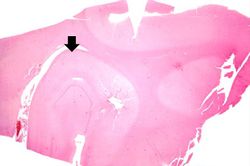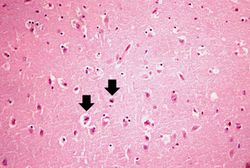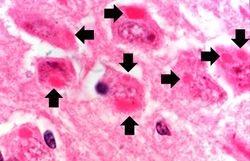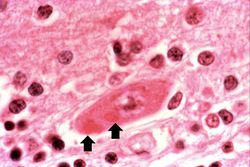Difference between revisions of "IPLab:Lab 8:Rabies"
Seung Park (talk | contribs) |
Seung Park (talk | contribs) |
||
| (7 intermediate revisions by the same user not shown) | |||
| Line 11: | Line 11: | ||
File:IPLab8Rabies5.jpg|This is a high-power photomicrograph of a neuron surrounded by inflammatory cells (lymphocytes and microglia). This neuron has two intracytoplasmic eosinophilic inclusion bodies (arrows). | File:IPLab8Rabies5.jpg|This is a high-power photomicrograph of a neuron surrounded by inflammatory cells (lymphocytes and microglia). This neuron has two intracytoplasmic eosinophilic inclusion bodies (arrows). | ||
</gallery> | </gallery> | ||
| + | |||
| + | == Virtual Microscopy == | ||
| + | <peir-vm>IPLab8Rabies</peir-vm> | ||
== Study Questions == | == Study Questions == | ||
| Line 16: | Line 19: | ||
* <spoiler text="What is the usual pathogenesis of rabies?">Rabies is usually transmitted by the bite of a rabid animal. The virus enters the CNS by ascending along the peripheral nerves from the wound site. The incubation period varies depending on the distance between the wound and the brain (commonly between 1 and 3 months).</spoiler> | * <spoiler text="What is the usual pathogenesis of rabies?">Rabies is usually transmitted by the bite of a rabid animal. The virus enters the CNS by ascending along the peripheral nerves from the wound site. The incubation period varies depending on the distance between the wound and the brain (commonly between 1 and 3 months).</spoiler> | ||
* <spoiler text="What is the usual clinical course of rabies?">The disease usually starts with nonspecific symptoms of malaise, headache, and fever, but the combination of these symptoms with local paresthesias around the site of the animal bite is diagnostic. In advanced cases, the patient exhibits severe CNS excitability progressing to convulsions. Contracture of the pharyngeal musculature when swallowing produces gagging and foaming at the mouth ("hydrophobia"). There is meningismus and, as the disease progresses, flaccid paralysis. Periods of alternating mania and stupor progress to coma and death from respiratory center failure.</spoiler> | * <spoiler text="What is the usual clinical course of rabies?">The disease usually starts with nonspecific symptoms of malaise, headache, and fever, but the combination of these symptoms with local paresthesias around the site of the animal bite is diagnostic. In advanced cases, the patient exhibits severe CNS excitability progressing to convulsions. Contracture of the pharyngeal musculature when swallowing produces gagging and foaming at the mouth ("hydrophobia"). There is meningismus and, as the disease progresses, flaccid paralysis. Periods of alternating mania and stupor progress to coma and death from respiratory center failure.</spoiler> | ||
| + | |||
| + | == Additional Resources == | ||
| + | === Reference === | ||
| + | * [http://emedicine.medscape.com/article/785543-overview eMedicine Medical Library: Emergency Treatment of Rabies] | ||
| + | * [http://emedicine.medscape.com/article/220967-overview eMedicine Medical Library: Rabies] | ||
| + | * [http://www.merckmanuals.com/professional/neurologic_disorders/brain_infections/rabies.html Merck Manual: Rabies] | ||
| + | * [http://www.merckmanuals.com/professional/neurologic_disorders/brain_infections/rabies.html?alt=sh#v1040958 Merck Manual: Rabies Postexposure Prophylaxis] | ||
| + | |||
| + | === Journal Articles === | ||
| + | * Jogai S, Radotra BD, Banerjee AK. [http://www.ncbi.nlm.nih.gov/pubmed/11132935 Immunohistochemical study of human rabies]. ''Neuropathology'' 2000 Sep;20(3):197-203. | ||
| + | |||
| + | === Images === | ||
| + | * [{{SERVER}}/library/index.php?/tags/1652-rabies PEIR Digital Library: Rabies Images] | ||
| + | * [http://library.med.utah.edu/WebPath/CNSHTML/CNSIDX.html#5 WebPath: CNS Infections] | ||
{{IPLab 8}} | {{IPLab 8}} | ||
[[Category: IPLab:Lab 8]] | [[Category: IPLab:Lab 8]] | ||
Latest revision as of 16:29, 3 January 2014
Contents
Clinical Summary
This 52-year-old female had been bitten by a dog two months previously. One week prior to death, she developed severe headache, restlessness, and dysphagia. These symptoms were followed by the appearance of fever, tremor, and general rigidity. The patient was admitted, but expired on the second hospital day.
Images
Virtual Microscopy
Study Questions
Additional Resources
Reference
- eMedicine Medical Library: Emergency Treatment of Rabies
- eMedicine Medical Library: Rabies
- Merck Manual: Rabies
- Merck Manual: Rabies Postexposure Prophylaxis
Journal Articles
- Jogai S, Radotra BD, Banerjee AK. Immunohistochemical study of human rabies. Neuropathology 2000 Sep;20(3):197-203.
Images
| |||||




